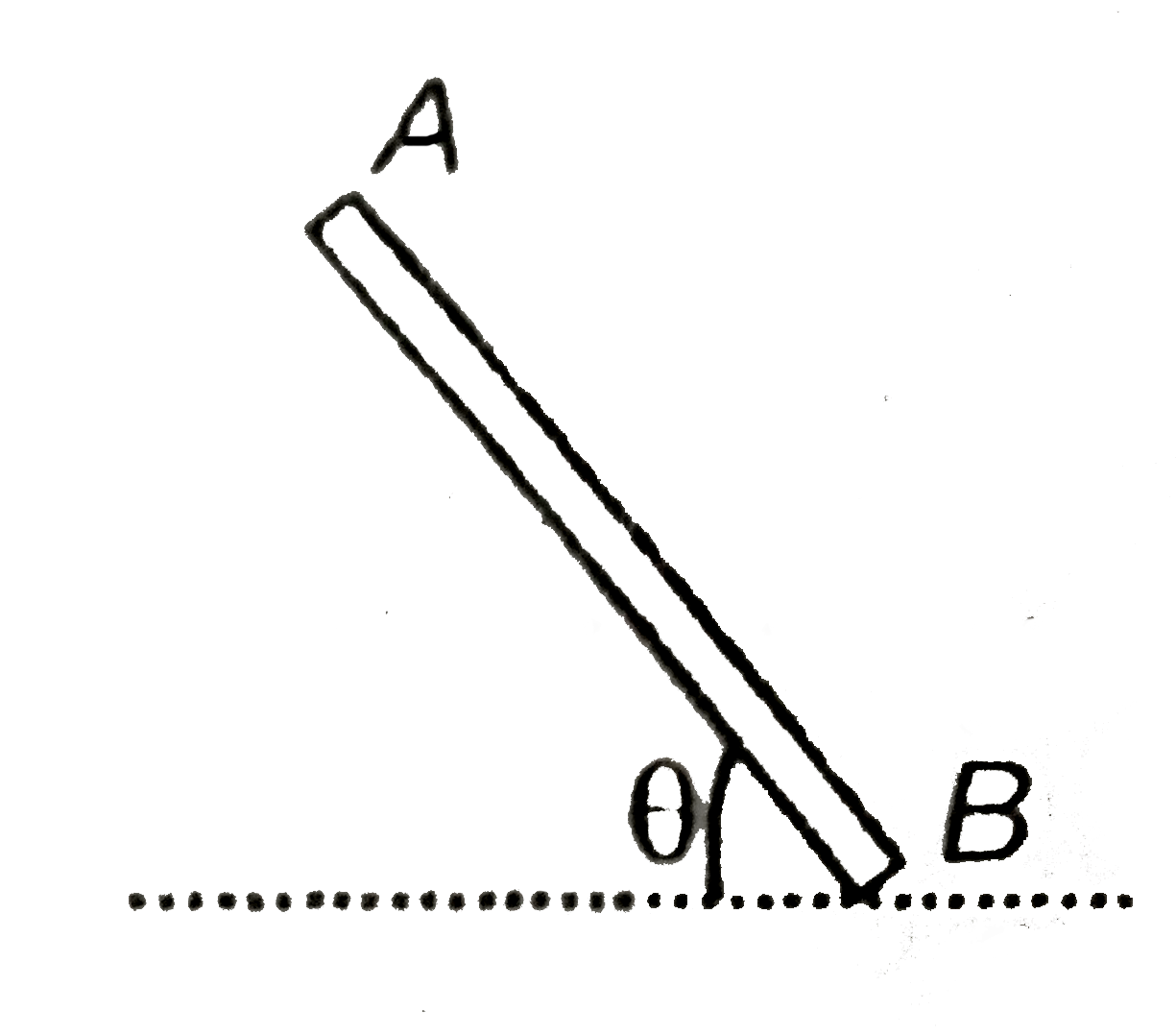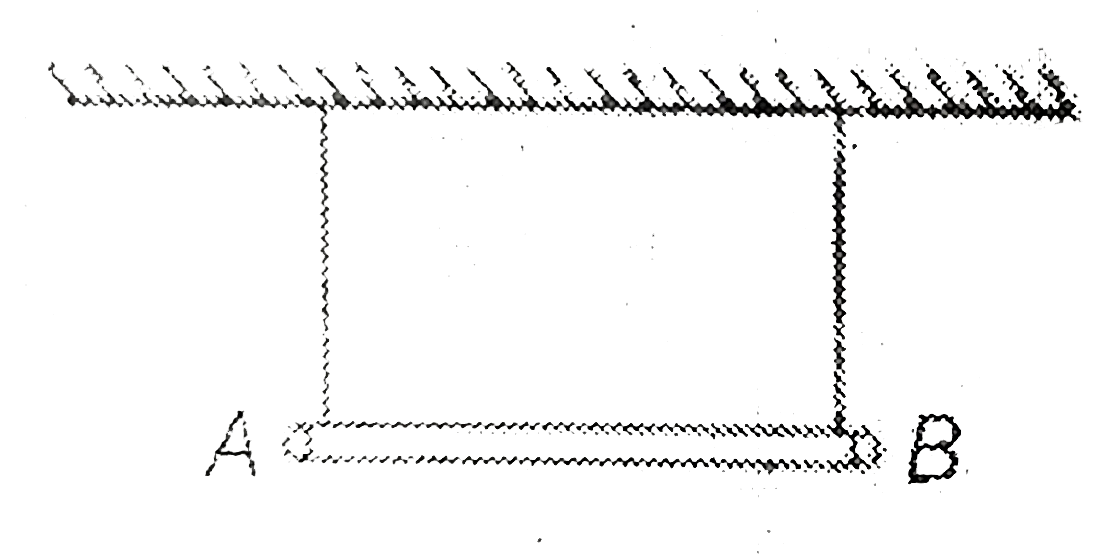Two men support a uniform rod of mass and length at its two ends. If one of them suddenly withdraws, find the force excerted by the rod on the other man
() immediately after withdrawl and
() when the rod makes angle with vertical.
The correct Answer is:A
To solve the problem, we need to analyze the forces acting on the rod in two scenarios: immediately after one man withdraws and when the rod makes an angle θ with the vertical.
Part (a): Immediately After Withdrawal
1. Identify the Forces:
- When one man withdraws, the rod's weight (Mg) acts downwards at its center of mass (which is at L/2 from either end).
- The remaining man exerts a normal force (N) upwards at one end of the rod.
2. Apply Newton's Second Law:
- The net force acting on the rod immediately after one man withdraws can be expressed as:
Mg−N=M⋅a
- Here, a is the linear acceleration of the center of mass of the rod.
3. Calculate the Angular Acceleration:
- The torque about the center of mass due to the weight of the rod is:
Torque=Mg⋅L2
- The moment of inertia (I) of the rod about its center of mass is:
I=ML23
- Using the relation for torque (τ=Iα):
Mg⋅L2=ML23⋅α
- Solving for α:
α=3g2L
4. Find Linear Acceleration:
- The linear acceleration of the center of mass is related to angular acceleration:
a=α⋅L2=3g2L⋅L2=3g4
5. Substitute Back to Find N:
- Substitute a back into the force equation:
Mg−N=M⋅3g4
- Rearranging gives:
N=Mg−3Mg4=Mg4
Conclusion for Part (a):
The force exerted by the rod on the other man immediately after withdrawal is:
N=Mg4
---
Part (b): When the Rod Makes an Angle θ with the Vertical
1. Identify Forces:
- The weight of the rod (Mg) acts downwards at its center of mass.
- The components of the weight at angle θ:
- Perpendicular component: Mgcosθ
- Parallel component: Mgsinθ
2. Apply Newton's Second Law:
- The net force in the vertical direction gives:
N+Mgsinθ=Mgcosθ
- Rearranging gives:
N=Mgcosθ−Mgsinθ
3. Torque Calculation:
- The torque about the pivot point (the end where the man is) due to the weight is:
Torque=Mg⋅L2sinθ
- Equating this to the moment of inertia times angular acceleration:
Mg⋅L2sinθ=ML23⋅α
4. Find Angular Acceleration:
- Solving for α:
α=3gsinθ2L
5. Find Linear Acceleration:
- The linear acceleration of the center of mass:
a=α⋅L2=3gsinθ2L⋅L2=3gsinθ4
6. Substitute Back to Find N:
- Substitute a back into the force equation:
Mgcosθ−N=M⋅3gsinθ4
- Rearranging gives:
N=Mgcosθ−3Mgsinθ4
Conclusion for Part (b):
The force exerted by the rod on the other man when it makes an angle θ with the vertical is:
N=Mgcosθ−3Mgsinθ4
---
- When one man withdraws, the rod's weight (Mg) acts downwards at its center of mass (which is at L/2 from either end).
- The remaining man exerts a normal force (N) upwards at one end of the rod.
- The net force acting on the rod immediately after one man withdraws can be expressed as:
Mg−N=M⋅a
- Here, a is the linear acceleration of the center of mass of the rod.
- The torque about the center of mass due to the weight of the rod is:
Torque=Mg⋅L2
- The moment of inertia (I) of the rod about its center of mass is:
I=ML23
- Using the relation for torque (τ=Iα):
Mg⋅L2=ML23⋅α
- Solving for α:
α=3g2L
- The linear acceleration of the center of mass is related to angular acceleration:
a=α⋅L2=3g2L⋅L2=3g4
- Substitute a back into the force equation:
Mg−N=M⋅3g4
- Rearranging gives:
N=Mg−3Mg4=Mg4
The force exerted by the rod on the other man immediately after withdrawal is:
N=Mg4
- The weight of the rod (Mg) acts downwards at its center of mass.
- The components of the weight at angle θ:
- Perpendicular component: Mgcosθ
- Parallel component: Mgsinθ
- The net force in the vertical direction gives:
N+Mgsinθ=Mgcosθ
- Rearranging gives:
N=Mgcosθ−Mgsinθ
- The torque about the pivot point (the end where the man is) due to the weight is:
Torque=Mg⋅L2sinθ
- Equating this to the moment of inertia times angular acceleration:
Mg⋅L2sinθ=ML23⋅α
- Solving for α:
α=3gsinθ2L
- The linear acceleration of the center of mass:
a=α⋅L2=3gsinθ2L⋅L2=3gsinθ4
- Substitute a back into the force equation:
Mgcosθ−N=M⋅3gsinθ4
- Rearranging gives:
N=Mgcosθ−3Mgsinθ4
The force exerted by the rod on the other man when it makes an angle θ with the vertical is:
N=Mgcosθ−3Mgsinθ4
Topper's Solved these Questions
- RACEBook:ALLENChapter:RACEExercise:Basic Maths (CIRCULAR MOTION)
Explore 17 Videos
- RACEBook:ALLENChapter:RACEExercise:Basic Maths (COLLISION AND CENTRE OF MASS )
Explore 12 Videos
- RACEBook:ALLENChapter:RACEExercise:Basic Maths (FRICTION)
Explore 14 Videos
- NEWTONS LAWS OF MOTIONBook:ALLENChapter:NEWTONS LAWS OF MOTIONExercise:EXERCISE-III
Explore 28 Videos
- SIMPLE HARMONIC MOTIONBook:ALLENChapter:SIMPLE HARMONIC MOTIONExercise:Example
Explore 1 Video
Similar Questions
Two men support a uniform horizontal beam at its two ends, if one of them suddenly lets go, the force exerted by the beam on the other man will
View SolutionMoment of inertia of a rod of mass m and length l about its one end is I. If one-fourth of its length is cut away, then moment of inertia of the remaining rod about its one end will be
View SolutionA uniform rod of mass m and length l is suspended about its end. Time period of small angular oscillations is

View SolutionA rod AB of mass M and length L is shown in figure. End A of rod is hinged and end B is lying on the ground. Find the Normal reaction by ground on the rod

View SolutionA rod of mass m and length l is rotating about a fixed point in the ceiling with an angular velocity ω as shown in the figure. The rod maintains a constant angle θ with the vertical.
What angle will the rod make with the vertical

View SolutionA uniform rod of mass m and length l is suspended by means of two light inextensible strings as shown in figure. Tension in one string immediately after the other string is cut is

View SolutionA uniform rod of mass and length l is suspended by two strings at its ends shown. When one of the strings is cut, the rod starts falling with an initial angular acceleration.

View SolutionA thin unifrom rod of mass m and length l is free to rotate about its upper end When it is at rest. It receives an impulse J as its lowest point, normal to its length immediately after impact.
View SolutionTwo boys are holding a horizontal rod of length L and weight W through its two ends. If now one of the boys suddenly leaves the rod, what is the instantaneous reaction force experienced by the other boy ?
View SolutionA uniform rod of mass M and length L lies flat on a frictionless horizantal surface. Two forces F and 2F are applied along the length of the rod as shown. The tension in the rod at point P is

View Solution